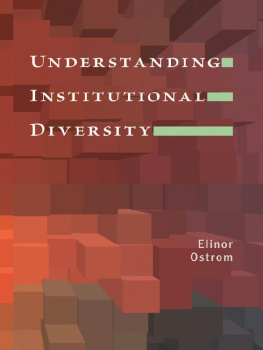UNDERSTANDING INSTITUTIONAL DIVERSITY
UNDERSTANDING INSTITUTIONAL DIVERSITY
Elinor Ostrom
PRINCETON UNIVERSITY PRESS PRINCETON AND OXFORD
Copyright 2005 by Princeton University Press
Published by Princeton University Press, 41 William Street,
Princeton, New Jersey 08540
In the United Kingdom: Princeton University Press,
3 Market Place, Woodstock, Oxfordshire OX20 1SY
All Rights Reserved
Library of Congress Cataloging-in-Publication Data
Ostrom, Elinor.
Understanding institutional diversity / Elinor Ostrom.
p. cm.
Includes bibliographical references and index.
ISBN-13: 978-0-691-12207-6 (cloth : alk. paper)
ISBN-10: 0-691-12207-5 (cloth : alk. paper)
ISBN-13: 978-0-691-12238-0 (pbk. : alk. paper)
ISBN-10: 0-691-12238-5 (pbk. : alk. paper)
1. Diversity in the workplace. 2. Multiculturalism. 3. Interpersonal
relations. 4. Organizational behavior. 5. Social norms. I. Title.
HF5549.5.M5O88 2005
302.35dc22 2004065772
British Library Cataloging-in-Publication Data is available
This book has been composed in Sabon
Printed on acid-free paper.
pup.princeton.edu
Printed in the United States of America
10 9 8 7 6 5 4 3 2 1
To the fabulous colleagues, students, visiting scholars, and staff who have made scholarship at the Workshop over the past thirty years highly productive, challenging, and rewarding
Contents
Illustrations
Figures
Tables
Acknowledgments
A NY BOOK DRAWING on unpublished and published papers that an author has drafted and thought about for multiple decades requires many acknowledgments. As I mention in several places in the volume, sections of this book were started in the 1980s when I was a research scholar at the Center for Interdisciplinary Research at Bielefeld University in Germany. I was fortunate enough to visit Bielefeld during 1982 and again in 1988. The opportunity to express some of my early thinking about nested sets of rules and action situations with colleagues participating in both Bielefeld groups is deeply appreciated and helped me immensely. I can remember the puzzlement of several colleagues when I decided to entitle a lecture given at Bielefeld in 1982 The Hidden Structure behind the Structure. In some respects, one may think of this book as my effort to uncover that hidden structure and to answer their many questions.
My major home base throughout this entire period, of course, has been the Workshop in Political Theory and Policy Analysis at Indiana University, Bloomington. Many earlier draft sections of what is now in this book have been presented at our colloquiums, at miniconference sessions, and in various working group meetings (e.g., the CPR Rules Coding Group, the Evolutionary Theory Working Group) at the Workshop. It has been an intellectual home for me where one could present radical ideas and get them taken seriously at the same time as they are being challenged and debated. The support of the Workshop by Indiana University is deeply appreciated.
Vincent Ostrom cofounded the Workshop with me more than thirty years ago, and his ideas permeate all that we do at the Workshop. None of us could have achieved what we have done without his inspiration, criticism, encouragement, and help, and there is no way of really adequately thanking him for years of lively discussions about the theoretical issues discussed in this book.
Throughout this period, we have been fortunate to receive funding from the National Science Foundation (SES-8619498; SES-8921888; SBR-9521918; SES-0083511), the Ford Foundation (95011601), and the MacArthur Foundation (0063798-GSS). Work with colleagues in the Resilience Alliance (supported by the McDonnell Foundation) has proved important during recent years and has helped to stimulate work on the last sections of the book. I was fortunate to spend a month with colleagues at the Max Planck Center for the Study of Common Goods in Bonn, Germany, during 2001. The staff there was very helpful and assisted me in getting a number of notes that had been written in the 1980s into text form.
In recent years, I have given a number of seminars at different universities on various sections of this book. These include: the Sanford School of Public Policy at Duke University in November 2001; the Department of Political Science, University of California, San Diego, in March 2002; as part of the Walker-Ames Lecture Series at the University of Washington in April 2002; Kathmandu University in April 2002; the Department of Economics and the Complex Systems Group at the University of Michigan in November 2002; the Max Planck Institute in Jena, Germany, in June 2003; Purdue University in October 2004; Cornell University in November 2004; Case Western University in January 2005; and at the Workshop itself on October 18, 2004, as well as in my seminar during the fall semesters of 2003 and 2004.
During the many years that colleagues and I have been trying to understand institutions, the occasion to write a number of papers and chapters have enabled coauthors and me to develop initial versions of many of the arguments in this volume. Thus, there are partial sections of earlier papers that are drawn on in multiple chapters of this volume, including:
: Elinor Ostrom, Institutional Rational Choice: An Assessment of the Institutional Analysis and Development Framework, in Theories of the Policy Process, ed. Paul A. Sabatier (Boulder, CO: Westview Press, 1999), pp. 3571; and Elinor Ostrom, Doing Institutional Analysis: Digging Deeper Than Markets and Hierarchies, in the Handbook of New Institutional Economics, ed. Claude Mnard and Mary Shirley (Dordrecht, the Netherlands: Springer, 2005), pp. 797926.
: Elinor Ostrom, Collective Action and the Evolution of Social Norms, Journal of Economic Perspectives 14 (3) (2000): 13758.
: Sue E. S. Crawford and Elinor Ostrom, A Grammar of Institutions, American Political Science Review 89 (3) (September 1995): 582600. (Reprinted with the permission of Cambridge University Press.) Reprinted in Polycentric Games and Institutions: Readings from the Workshop in Political Theory and Policy Analysis, ed. Michael McGinnis (Ann Arbor: University of Michigan Press, 2000), pp. 11455. Figures and tables reprinted with the permission of the University of Michigan Press.
: Elinor Ostrom, Reformulating the Commons, in Protecting the Commons: A Framework for Resource Management in the Americas, ed. Joanna Burger, Elinor Ostrom, Richard B. Norgaard, David Policansky, and Bernard D. Goldstein (Washington, D.C.: Island Press, 2001), pp. 1741.
: Elinor Ostrom, Coping with Tragedies of the Commons, Annual Review of Political Science 2 (1999): 493535. (Reprinted with permission of the Annual Review of Political Science. )
: Elinor Ostrom, Institutional Analysis, Design Principles, and Threats to Sustainable Community Governance and Management of Commons, in Law and the Governance of Renewable Resources: Studies from Northern Europe and Africa, ed. Erling Berge and Nils Christian Stenseth (Oakland, CA: ICS Press, 1998), pp. 2753.
As I work on this book, I am deeply appreciative of the long conversations that I have had with colleagues about the Institutional Analysis and Development (IAD) framework, which many of us have had a direct role in creating. The many conversations and memos shared with Larry Kiser and Sue Crawford are particularly important in affecting my own thinking, and working with Roy Gardner and James Walker to model these ideas using game theory and build experimental games to test our predictions has been invaluable. Roger Parks has repeatedly given me extensive comments on earlier manuscripts that have challenged me to work still harder to explain the concepts. Marco Janssen and Mike McGinnis have both read and commented extensively on sections of this manuscript. Working with T. K. Ahn on multiple papers has also added to my understanding. Chuck Myers at Princeton University Press has given me many useful suggestions and has been extremely helpful through the final year of moving an amorphous manuscript toward being a real book. Cindy Crumrine, who copyedited this book for Princeton University Press, did an outstanding job. The anonymous reviewers for Princeton University Press also provided useful advice. Eric Coleman has read through the final draft with a critical and useful eye and developed the index for this book. Without Patty Lezottes excellent editing skills, thoughtful insights, and cheerful help under high stress, I do not know how I could have finished this book.












